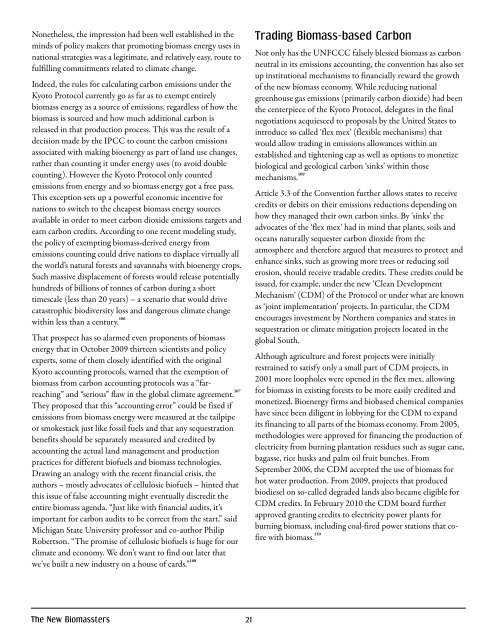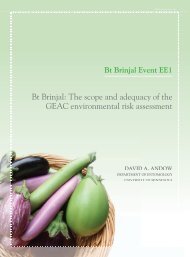English - pdf - 2145 Kb - Biosafety Information Centre
English - pdf - 2145 Kb - Biosafety Information Centre
English - pdf - 2145 Kb - Biosafety Information Centre
- No tags were found...
You also want an ePaper? Increase the reach of your titles
YUMPU automatically turns print PDFs into web optimized ePapers that Google loves.
Nonetheless, the impression had been well established in theminds of policy makers that promoting biomass energy uses innational strategies was a legitimate, and relatively easy, route tofulfilling commitments related to climate change.Indeed, the rules for calculating carbon emissions under theKyoto Protocol currently go as far as to exempt entirelybiomass energy as a source of emissions, regardless of how thebiomass is sourced and how much additional carbon isreleased in that production process. This was the result of adecision made by the IPCC to count the carbon emissionsassociated with making bioenergy as part of land use changes,rather than counting it under energy uses (to avoid doublecounting). However the Kyoto Protocol only countedemissions from energy and so biomass energy got a free pass.This exception sets up a powerful economic incentive fornations to switch to the cheapest biomass energy sourcesavailable in order to meet carbon dioxide emissions targets andearn carbon credits. According to one recent modeling study,the policy of exempting biomass-derived energy fromemissions counting could drive nations to displace virtually allthe world’s natural forests and savannahs with bioenergy crops.Such massive displacement of forests would release potentiallyhundreds of billions of tonnes of carbon during a shorttimescale (less than 20 years) – a scenario that would drivecatastrophic biodiversity loss and dangerous climate changewithin less than a century. 106That prospect has so alarmed even proponents of biomassenergy that in October 2009 thirteen scientists and policyexperts, some of them closely identified with the originalKyoto accounting protocols, warned that the exemption ofbiomass from carbon accounting protocols was a “farreaching”and “serious” flaw in the global climate agreement. 107They proposed that this “accounting error” could be fixed ifemissions from biomass energy were measured at the tailpipeor smokestack just like fossil fuels and that any sequestrationbenefits should be separately measured and credited byaccounting the actual land management and productionpractices for different biofuels and biomass technologies.Drawing an analogy with the recent financial crisis, theauthors – mostly advocates of cellulosic biofuels – hinted thatthis issue of false accounting might eventually discredit theentire biomass agenda. “Just like with financial audits, it’simportant for carbon audits to be correct from the start,” saidMichigan State University professor and co-author PhilipRobertson. “The promise of cellulosic biofuels is huge for ourclimate and economy. We don’t want to find out later thatwe’ve built a new industry on a house of cards.” 108Trading Biomass-based CarbonNot only has the UNFCCC falsely blessed biomass as carbonneutral in its emissions accounting, the convention has also setup institutional mechanisms to financially reward the growthof the new biomass economy. While reducing nationalgreenhouse gas emissions (primarily carbon dioxide) had beenthe centerpiece of the Kyoto Protocol, delegates in the finalnegotiations acquiesced to proposals by the United States tointroduce so called ‘flex mex’ (flexible mechanisms) thatwould allow trading in emissions allowances within anestablished and tightening cap as well as options to monetizebiological and geological carbon ‘sinks’ within thosemechanisms. 109Article 3.3 of the Convention further allows states to receivecredits or debits on their emissions reductions depending onhow they managed their own carbon sinks. By ‘sinks’ theadvocates of the ‘flex mex’ had in mind that plants, soils andoceans naturally sequester carbon dioxide from theatmosphere and therefore argued that measures to protect andenhance sinks, such as growing more trees or reducing soilerosion, should receive tradable credits. These credits could beissued, for example, under the new ‘Clean DevelopmentMechanism’ (CDM) of the Protocol or under what are knownas ‘joint implementation’ projects. In particular, the CDMencourages investment by Northern companies and states insequestration or climate mitigation projects located in theglobal South.Although agriculture and forest projects were initiallyrestrained to satisfy only a small part of CDM projects, in2001 more loopholes were opened in the flex mex, allowingfor biomass in existing forests to be more easily credited andmonetized. Bioenergy firms and biobased chemical companieshave since been diligent in lobbying for the CDM to expandits financing to all parts of the biomass economy. From 2005,methodologies were approved for financing the production ofelectricity from burning plantation residues such as sugar cane,bagasse, rice husks and palm oil fruit bunches. FromSeptember 2006, the CDM accepted the use of biomass forhot water production. From 2009, projects that producedbiodiesel on so-called degraded lands also became eligible forCDM credits. In February 2010 the CDM board furtherapproved granting credits to electricity power plants forburning biomass, including coal-fired power stations that cofirewith biomass. 110The New Biomassters 21











